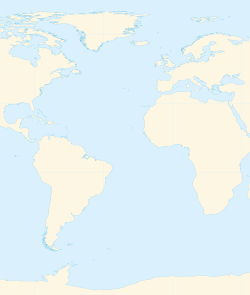From Wikipedia, the free encyclopedia
"Atlantic", "North Atlantic", "South Atlantic", "Atlantic Basin", and "Atlantic coast" redirect here. For other uses, see Atlantic (disambiguation), North Atlantic (disambiguation), South Atlantic (disambiguation), Atlantic Basin (disambiguation), and Atlantic Coast (disambiguation).
| Atlantic Ocean | |
|---|---|
 |
|
| Coordinates | 0°N 25°WCoordinates: 0°N 25°W[1] |
| Basin countries | List of countries, ports |
| Surface area | 106,460,000 km2 (41,100,000 sq mi)[2][3] North Atlantic: 41,490,000 km2 (16,020,000 sq mi), South Atlantic 40,270,000 km2 (15,550,000 sq mi)[4] |
| Average depth | 3,646 m (11,962 ft)[4] |
| Max. depth | 8,486 m (27,841 ft)[4] |
| Water volume | 310,410,900 km3 (74,471,500 cu mi)[4] |
| Shore length1 | 111,866 km (69,510 mi) including marginal seas[1] |
| Islands | List of islands |
| Trenches | Puerto Rico; South Sandwich; Romanche |
| 1 Shore length is not a well-defined measure. | |
This video was taken by the crew of Expedition 29 on board the ISS. The pass starts from just northeast of the island of Newfoundland over the North Atlantic Ocean to central Africa, over South Sudan.
The Atlantic Ocean occupies an elongated, S-shaped basin extending longitudinally between Eurasia and Africa to the east, and the Americas to the west. As one component of the interconnected global ocean, it is connected in the north to the Arctic Ocean, to the Pacific Ocean in the southwest, the Indian Ocean in the southeast, and the Southern Ocean in the south (other definitions describe the Atlantic as extending southward to Antarctica). The Equatorial Counter Current subdivides it into the North Atlantic Ocean and South Atlantic Ocean at about 8°N.[5]
Scientific explorations of the Atlantic include the Challenger expedition, the German Meteor expedition, Columbia University's Lamont-Doherty Earth Observatory and the United States Navy Hydrographic Office.[5]


No comments:
Post a Comment